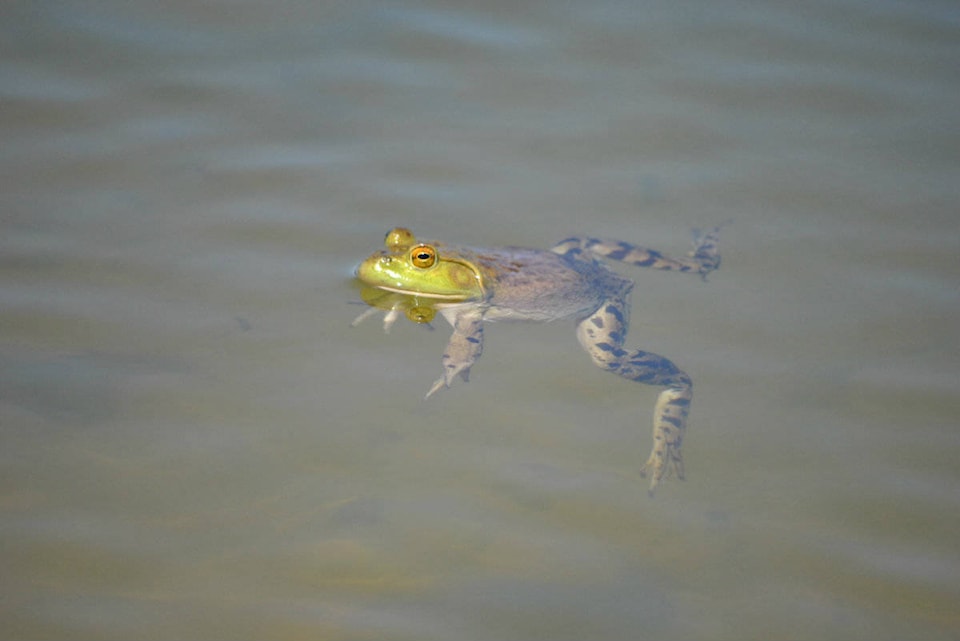Since 2007, Stan Orchard and his small crew of four have kept one of the most ravenous and invasive species in the region from overwhelming the Greater Victoria Water Supply.
At the corridor between Esquimalt Lagoon and Finlayson Arm, located at the narrowest point of the Saanich Peninsula, his control operation stems the flow of the American bullfrog approaching from unmanaged populations to the east.
Due to the size of the crew, patrolling can be a “big” problem, he said.
ALSO READ: Spread of invasive species in Canada costs billions
“You’re dealing with a species that every female can produce 20,000 and more eggs in a year.”
The frogs migrate in search of food and water, often gobbling up native species along the way. Their ecological footprint is “huge,” he explained.
“They’re eating everything that’ll fit in their mouth, both above and below the water.”
A 2013 study co-authored by Orchard, found the stomach contents of 5,200 American bullfrogs contained 15 classes of organisms. This included smaller native frogs, local salamanders and songbirds that come down to the water’s edge to drink.
“We’ve taken coho salmon and bats out of their stomachs,” he noted. At Langford Lake, they indulge in the eggs of endangered western painted turtles.
As part of CRD’s control program, at least one of Orchard’s two two-person crews work throughout the active bullfrog season, from late-April to mid-October. Currently, the crew focuses on 12 sites in the CRD, including Langford, Florence and Glen Lakes and associated ponds.
ALSO READ: Officials want feral pigs stopped before they go hog wild
To capture the frogs, a team cruises out to shallow waters on sturdy inflatable boats. One person rows the boat backwards while the other uses a spotlight to catch a reflection of the frog’s eyes. While they’re dazzled by the bright light, the crew can row closer.
Using Orchard’s patented ‘electro-frogger’ – a seven-foot pole that generates an electrical field 15 inches across – the frog is zapped, scooped up and placed in a bucket.
Once the pole is engaged, the frog’s “hind legs go straight out, and it goes stiff as a board for about a minute,” he added. The captured frogs are subsequently “humanely” euthanized, measured and composted.
Covering all 12 sites can be difficult for several reasons. “We’re trying to deploy at least one crew every one of those 175 days,” Orchard said. However, the inflatable boats tend to blow around when the breeze gets above 15 kilometers an hour, and crews aren’t able to work when it’s raining.
Funding is another challenge.
ALSO READ: Highlands residents tackle bullfrog menace
Although it varies from site to site, “we can cover about two kilometers of margin in an evening,” Orchard said. When it comes to Langford Lake, which is about eight kilometers around, it takes “five to six nights, probably, to comprehensively cover all the margins,” he noted.
“We’re a bit undermanned given the geographical scope.”
Recently, the district of Metchosin municipal hall has been requesting Orchard’s service and deciding on funding because of their own bullfrog problem.
The frogs have been moving around Happy Valley Road at Lindholm Road and Bennett Road. They’ve also been spotted expanding toward Blinkhorn Lake on Kangaroo Road, Orchard said.
With no clear migration path spotted, Orchard said he believes a human introduced them to the area.
The first generation of bullfrogs are thought to be introduced to the Island’s ecosystem in Saanich by two people who claimed to be farming for frog legs in their backyard and a child releasing his pet into the wild.
People need to educate themselves or they can be very destructive when it comes to getting rid of tadpoles, Orchard said. He receives calls “every year around March” from people who say they have gone out and collected bullfrog eggs and destroyed them.
“Bullfrogs don’t reproduce in March. Those are native Northwestern salamanders, red-legged frogs, Pacific tree frogs,” he said. Bullfrog eggs hatch around mid-summer, when water temperatures are around 25 degrees, and quickly grow to around six inches long, he noted.
“And so, they wiped out a whole generation.”
swikar.oli@goldstreamgazette.com
Like us on Facebook and follow us on Twitter
